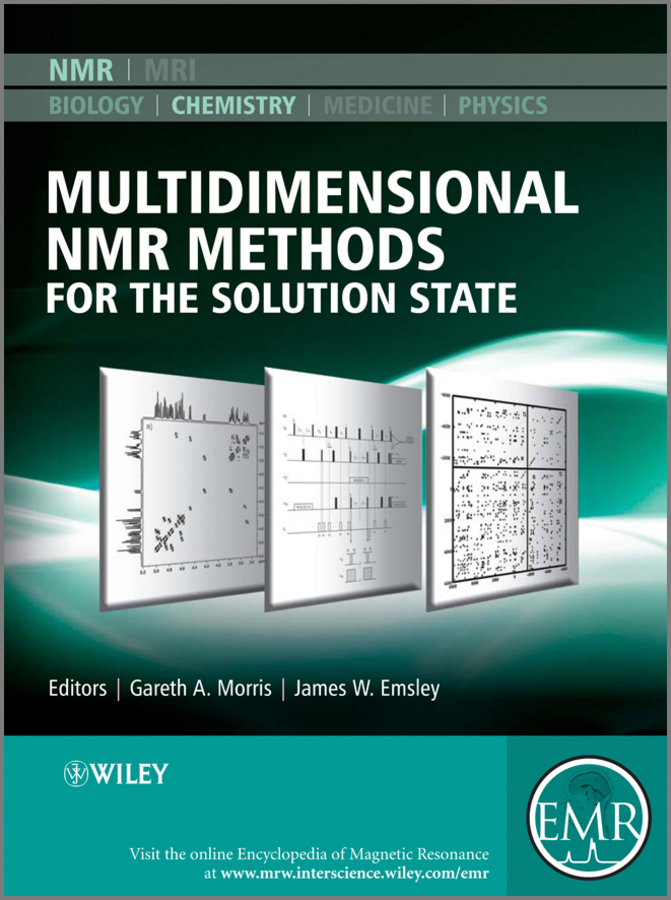Электронная книга: Gareth Morris A. «Multidimensional NMR Methods for the Solution State»

|
The content of this volume has been added to eMagRes (formerly Encyclopedia of Magnetic Resonance)– the ultimate online resource for NMR and MRI. The literature of multidimensional NMR began with the publication of three papers in 1975, then nine in 1976 and fifteen in 1977, and now contains many tens of thousands of papers. Any attempt to survey the field must therefore necessarily be very selective, not to say partial. In assembling this handbook, the Editors have sought to provide both the new researcher and the established scientist with a solid foundation for the understanding of multidimensional NMR, a representative if inevitably limited survey of its applications, an authoritative account of classic techniques such as COSY, NOESY and TOSCY, and an account of the latest progress in the development of multidimensional techniques. This handbook is structured in four parts. The first opens with an historical introduction to, and a brief account of, the practicalities and applications of multidimensional NMR methods, followed by a definitive survey of their conceptual basis and a series of articles setting out the generic principles of methods for acquiring and processing multidimensional NMR data. In the second part, the main families of multidimensional techniques, arranged in approximate order of increasing complexity, are described in detail, from simple J-resolved spectroscopy through to the powerful heteronuclear 3D and 4D methods that now dominate the study of structural biology in solution. The third part offers and illustrative selection from the very wide range of applications of multidimensional NMR methods, including some of the most recent developments in protein NMR. Finally, the fourth part introduces the idea of multidimensional spectra containing non-frequency dimensions, in which properties such as diffusion and relaxation are correlated. About EMR Handbooks / eMagRes Handbooks The Encyclopedia of Magnetic Resonance (up to 2012) and eMagRes (from 2013 onward) publish a wide range of online articles on all aspects of magnetic resonance in physics, chemistry, biology and medicine. The existence of this large number of articles, written byexperts in various fields, is enabling the publication of a series of EMR Handbooks / eMagRes Handbooks on specific areas of NMR and MRI. The chapters of each of these handbooks will comprise a carefully chosen selection of articles from eMagRes. In consultation with the eMagRes Editorial Board, theEMR Handbooks / eMagRes Handbooks are coherently planned in advance by specially-selected Editors, and new articles are written (together with updates of some already existing articles) to give appropriate complete coverage. The handbooks are intended to be of value and interest to research students, postdoctoral fellows and other researchers learning about the scientific area in question and undertaking relevant experiments, whether in academia or industry. Have the content of this Handbook and the complete content of eMagRes at your fingertips! Visit: www.wileyonlinelibrary.com/ref/eMagResView other eMagRes publications here Издательство: "John Wiley&Sons Limited"
ISBN: 9781118589106 электронная книга Купить за 13126.82 руб и скачать на Litres |
Другие книги схожей тематики:
| Автор | Книга | Описание | Год | Цена | Тип книги |
|---|
См. также в других словарях:
NMR spectroscopy — Nuclear magnetic resonance spectroscopy, most commonly known as NMR spectroscopy, is the name given to a technique which exploits the magnetic properties of certain nuclei. This phenomenon and its origins are detailed in a separate section on… … Wikipedia
Solid-state nuclear magnetic resonance — (NMR) spectroscopy, characterized by the presence of anisotropic (directionally dependent) interactions.IntroductionBasic conceptsA spin interacts with a magnetic or an electric field. Spatial proximity and/or a chemical bond between two atoms… … Wikipedia
Nuclear magnetic resonance — This article is about the physical phenomenon. For its use as a method in spectroscopy, see Nuclear magnetic resonance spectroscopy. NMR redirects here. For other uses, see NMR (disambiguation). First 1 GHz NMR Spectrometer (1000 MHz,… … Wikipedia
Nuclear magnetic resonance spectroscopy — A 900MHz NMR instrument with a 21.2 T magnet at HWB NMR, Birmingham, UK Nuclear magnetic resonance spectroscopy, most commonly known as NMR spectroscopy, is a research technique that exploits the magnetic properties of certain atomic nuclei… … Wikipedia
Nuclear magnetic resonance spectroscopy of proteins — (usually abbreviated protein NMR) is a field of structural biology in which NMR spectroscopy is used to obtain information about the structure and dynamics of proteins. The field was pioneered by Richard R. Ernst and Kurt Wüthrich[1], among… … Wikipedia
Protein nuclear magnetic resonance spectroscopy — (usually abbreviated protein NMR) is a field of structural biology in which NMR spectroscopy is used to obtain information about the structure and dynamics of proteins. The field was pioneered by, among others, Kurt Wüthrich, who shared the Nobel … Wikipedia
